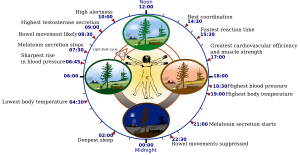Everyone has heard of the circadian rhythm, the internal body clock that regulates certain processes within our bodies. What many of us don’t know is important this biological clock is in our ability to sleep.
If you have ever wondered why we adhere to a 24 hour day, you may have attributed it to the planetary rotation that is responsible for creating a period of light and a period of darkness that generally repeats every 24 hours. It makes sense that we would base our calculation of time on something as universally experienced and consistent as the rotation of the planet. Given this, it is little wonder that the biological clocks of plants and animals, including humans, are also aligned with this cycle. Our internal clock uses the shifts from light to dark and back to light as cues to trigger specific biological processes. In essence, we are pre-programmed to go to sleep when our eyes tell our brain it is dark and wake up when our eyes tell our brain it is light.
But what if you can’t see darkness and you can’t see light?
This is the case for many people who are completely blind. Because their eyes can’t send the same signals to the brain, they may suffer from a sleep disorder called Non-24 Sleep Wake Disorder. In people with this disorder, the circadian rhythm is not synchronized to this 24 hours cycle. In the blind, this lack of synchronization results from the inability of the eyes to tell the brain if it is light or dark but sighted people can also suffer from this disorder. People with Non-24 have circadian rhythms that are generally longer than 24 hours. What this means is that their biological day is not triggered by the shift from dark to light in the same way as those without the condition. This can lead to sleep onset delay that shifts by a certain amount everyday eventually resulting in the person being awake all night and unable to stay awake during the day. To understand this better, here is an example. If a person with Non-24 has a circadian rhythm that runs at 25 hours rather than 24, the time their body is ready to sleep will be an hour later each night. After 12 nights, their day and night will have swapped places.
The biggest problem this disorder causes is periods of poor sleep accompanied by excessive daytime sleepiness. Because the person’s internal clock is not in synch with the 24 hour cycle they will struggle to fall asleep and wake up at the right times. The cyclical nature of this disorder is one of the ways it can be differentiated from other sleep disorders with similar symptoms. People with the disorder will experience a cycle consisting of a period of good sleep followed by a period of poor sleep that repeats.
Although it is possible for sighted people to have this disorder, the majority of those who are diagnosed are those who also suffer from total blindness. Diagnosis of Non-24 should only be made by a specialized sleep professional since it can be confused with other disorders. For more information on Non-24 Sleep Wake Disorder, visit the National Sleep Foundation’s Non-24 information site.
Related articles
- Everything You Need to Know to Help Children Get a Good Night Sleep (valleysleepcenter.com)
- 1o Tips for Sleeping Through the Heat (valleysleepcenter.com)
- Sleeping in on Saturday May Make Your Sleepy All Week Long (valleysleepcenter.com)


